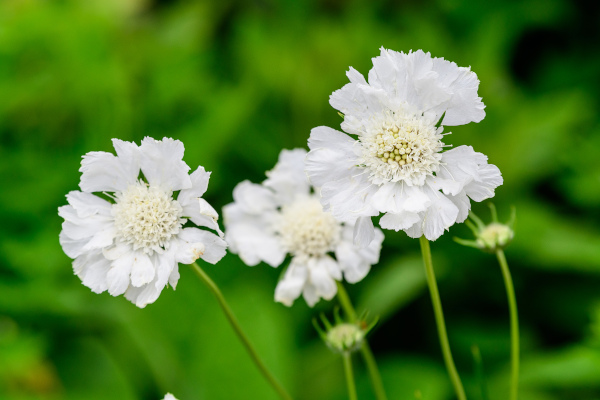How to grow Cephalaria
Also known as giant scabious, Cephalaria is a flowering plant in the same family as teasel, honeysuckle, and yes – scabious. Of 65 species, by far the most popular is Cephalaria gigantea, a tall perennial originating from moist soils in the Caucasus. Whilst this plant can reach a height of around 2m tall, it has a surprisingly light, airy presence and relatively small footprint in the border. It is grown for its deeply cut, aniseed-scented foliage from which tall, wiry, branching stems emerge, bearing a succession of primrose-yellow, pincushion flowerheads throughout summer. These attract a range of pollinators.
Cephalaria is known as an easy-going, adaptable, long-flowering plant which thrives with the minimum of fuss. It is quick to bulk up and will self-seed gently in the surrounding area.
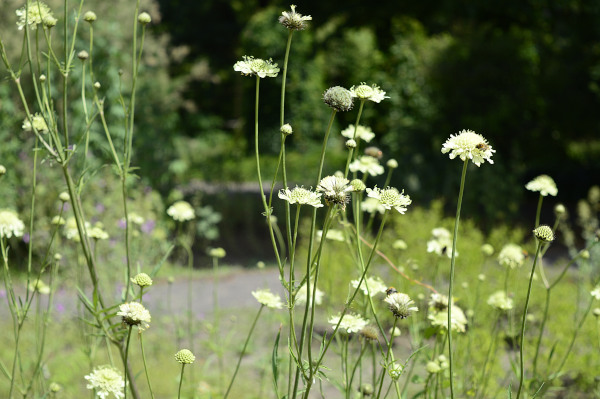
Zantedeschia is a genus of flowering plants from the family Araceae and is native to southern Africa. With a rich history dating back to the Ancient Romans, these deciduous or semi-evergreen perennials have been used as a symbol of celebration. Zantedeschia was Named after Professor Giovanni Zantedeschia, an Italian botanist.
There are two main forms of Zantedeschia: hardy and tender. Hardy forms of the plant can be grown outdoors, enjoy moist soil and full sun or partially shaded conditions - these are known as Arum lilies. Tender forms of Zantedeschia prefer being grown in containers or pots and should be brought inside over the winter - these are known as Calla lilies.
With tuberous flora in all colours from whites, yellows and oranges to deep reds and purples, Zantedeschias are not to be overlooked in any garden, as long as they have sufficient sunlight to grow in.
Ready to learn more about growing Zantedeschia? Read on for all there is to know...

Key Information
Soil pH
Position
Hardiness

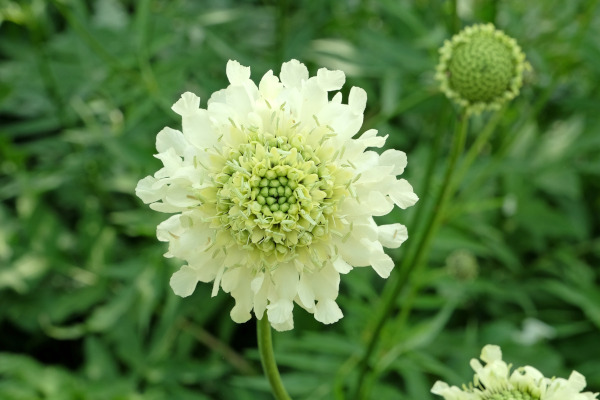
Where & when to plant Cephalaria
Position - Grown in a sunny or lightly shaded spot out of the wind, the stems should be self-supporting. In an exposed or significantly shaded location they are likely to require support.
Soil - Fertile, moist, well-draining. Cephalaria dislikes sitting in waterlogged soil so take care to avoid this.
Flowering Period - Summer
Hardiness - Rated H7, i.e., capable of surviving temperatures of -20°C and beyond. As hardy as it gets.
For best results, plant in autumn or spring. An autumn planting can be done by those gardening in mild conditions (and broadly speaking, this is the southern half of the UK). For those liable to cold, wet winters, it is best to wait until spring (generally the northern half of the UK). Planting can also be carried out in summer, though avoid very hot, dry weather and be prepared to water regularly.
With its informal, swaying, airy appearance cephalaria is perfect for a cottage garden or wildflower scheme, where it is best planted in the middle to back of a border or bed. Most impressive results come from growing several plants grouped together or even more to create a large drift. While it is possible to have short-term success in a container, a deep root means open ground is best in the long term.
How to plant Cephalaria
- For planting in the garden, dig the soil area removing any large stones and weeds and breaking up any lumps. If your soil is on the poor, dry side, now is the time to mix in some well-rotted organic matter such as manure or garden compost. Rake level and firm with your heels. Rake level again.
- Water plants well and allow to drain before planting.
- Dig a hole twice the size of the root-ball.
- Place the plant in the hole, ensuring the top of the root ball sits level with the surface of the soil. Too low and the plant may rot, too high and the roots can dry out.
- Backfill with soil and firm in gently with your foot.
- Soak well with water.
- Mulch around the base with manure or garden compost.
- For planting in a container, choose a deep pot with plenty of drainage holes in the bottom.
- Use a good quality potting compost with a handful or two of horticultural grit mixed in, and, if not already present in the compost (check the description on the bag) some slow-release fertiliser granules.
- Start by partially filling the pot with compost; enough so that when placed on it the upper surface of the root ball is about 3cm lower than the top of the pot.
- Infill all the space surrounding the root ball with compost, firming down with your fingers then adding a little more so the plant is held tight.
- Pick up the container and lightly tap on the potting bench or ground a few times to help further settle the compost around the plant.
- Soak well with water.
- A mulch with horticultural grit will look attractive and help to prevent a ‘cap’ or crust forming on the top of the compost (something container plants can suffer due to the artificial nature of their watering).
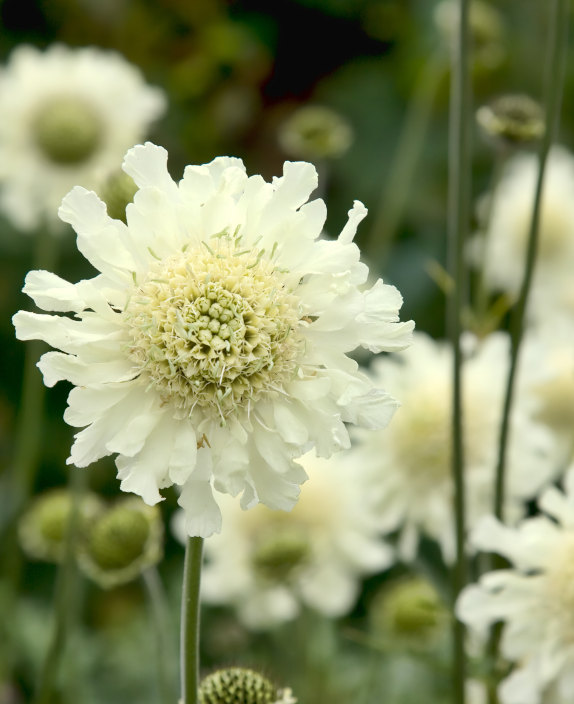
What to plant with Cephalaria
Cephalaria pairs beautifully with other billowing, naturalistic companions such as Verbena bonariensis, thalictrum, aquilegia, digitalis, cirsium, and dierama. Add fullness and movement with ornamental grasses including miscanthus, stipa, and pennisetum.
If you would like any further planting ideas or growing advice for your Cephalaria, please contact our friendly and knowledgeable Customer Care Team - we will be more than happy to help you.
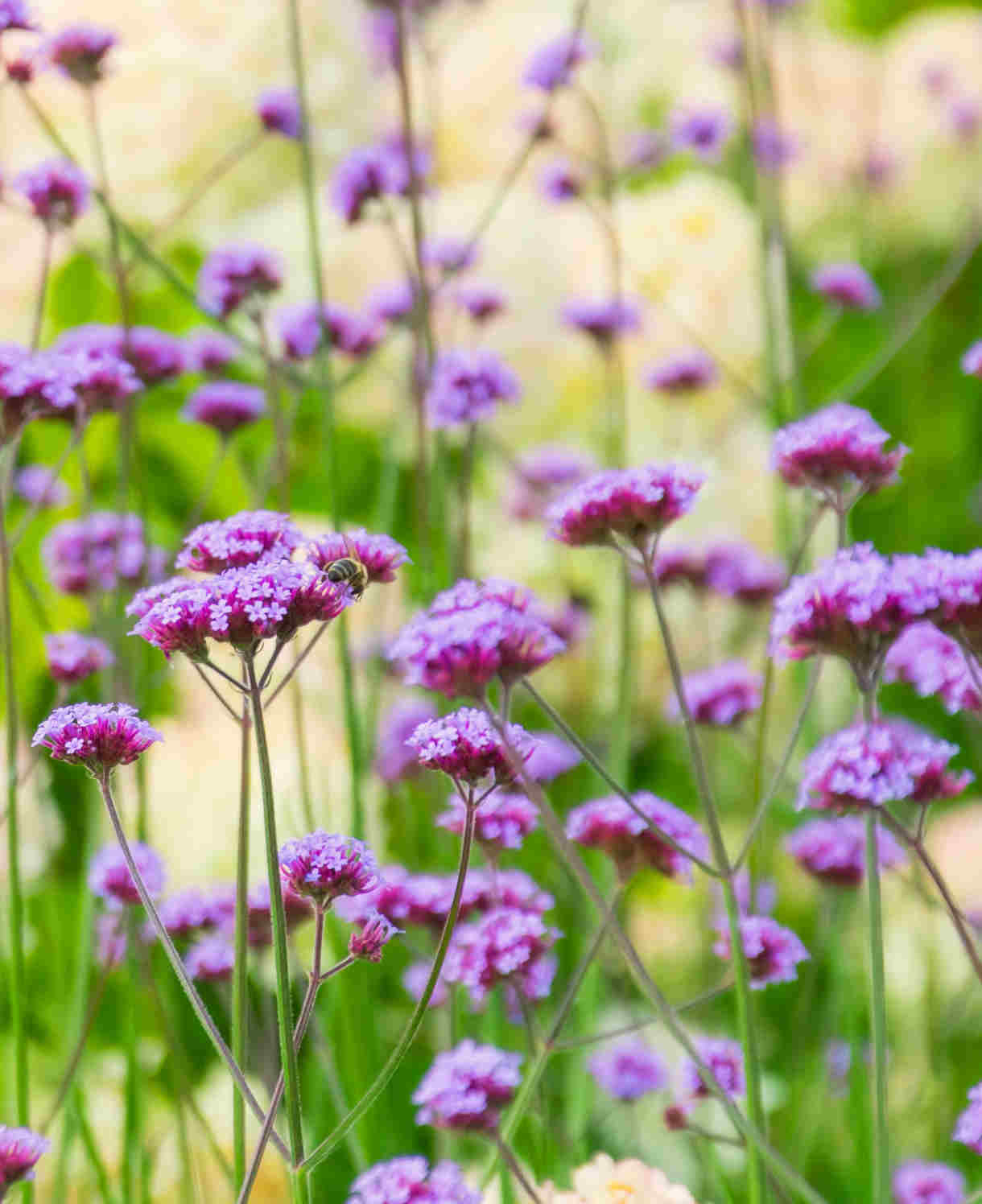
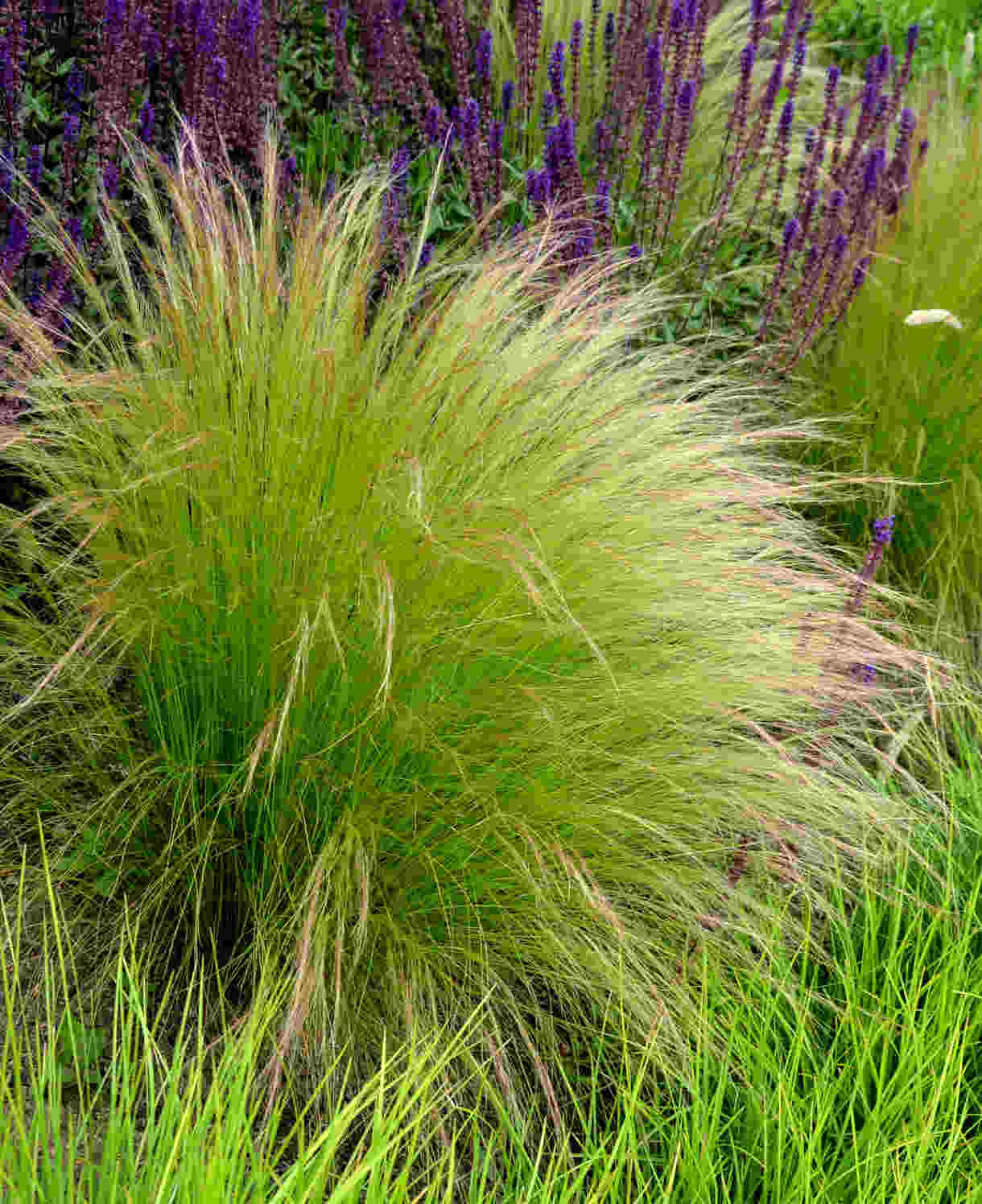
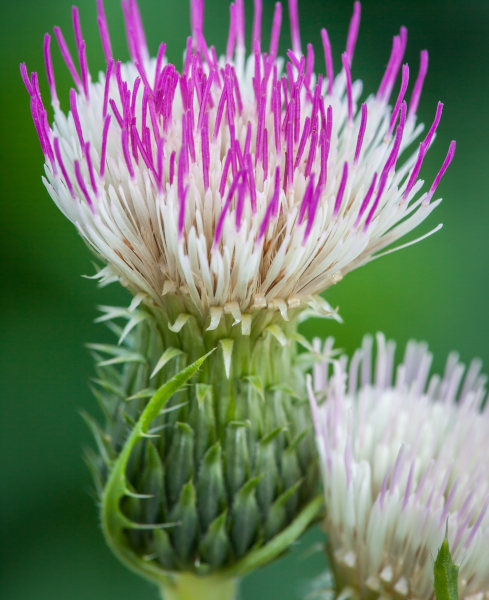
How to care for Cephalaria
Pruning and Deadheading
If you wish to prevent cephalaria self-seeing, remove spent flowerheads before they have the chance to set seed. This can also encourage the formation of more flowers. Cutting all flowered stems down to the ground after flowering may sometimes result in a second flush in September.
If you can, resist the urge to chop the whole plant down in autumn – leaving the dried and withered top growth intact provides a habitat for overwintering wildlife, and birds will enjoy feasting on the seeds. Cut back in spring just before growth resumes.
Watering
Cephalaria in the ground should be given a good watering in on planting and a couple more times after this, then should be self-sufficient in all but the hottest, driest weather. Having said this, keeping the soil consistently moist will result in larger plants and prevent the foliage from browning off in summer, which it is prone to do in dry spells (fortunately, the usual positioning of these plants further back means their foliage tends to be obscured by others).
Cephalaria in a container requires regular watering throughout the growing season. To avoid overwatering (this plant dislikes sitting in soggy compost), a good rule of thumb is to allow the top couple of centimetres to dry out between soakings. To check this, wiggle your finger down into the compost until you feel moisture. Be aware that in the height of summer containers may need watering every day, especially those which are small or very full.
Feeding
Cephalaria is not a hungry plant and on healthy, fertile soil shouldn’t require feeding to perform well. Having said this, it will benefit from an annual mulch, not least to lock moisture into the soil. This means applying a layer of well-rotted organic matter (i.e., leaf mould, manure, or garden compost) to the surface of the soil around the base
If you garden on particularly poor or sandy soil, applying a general-purpose granular feed to the surface of the soil and lightly working it in can provide a welcome boost. This is known as a top dress and can be done in spring.
Container-grown plants are different as they rely solely on the gardener for nutrition. Get off to a flying start by making sure you use a good quality compost with slow-release granules mixed in. These generally provide nutrients for around 6 to 8 weeks, after which a liquid feed every 4 weeks until the end of the growing season will ensure a healthy, thriving plant.
Cold Protection
Cephalaria is fully hardy and able to withstand even a harsh UK winter without the need for additional protection.
Pests and Diseases
Cephalaria is considered trouble-free.
How to propagate Cephalaria
Over time, cephalaria will self-seed gently (providing the seedheads are left intact), and you may also collect and sow seed yourself in containers in a cold frame in early spring. The quickest method, however, is to lift and divide mature plants during early or mid-spring. Cephalaria is quick to establish so you should find plants are large enough for this within a couple of years.
- Choose a day when the soil is not frozen or waterlogged, ideally once the plant has started to regrow.
- Dig the plant out of the ground.
- Shake off any excess soil.
- Separate into sections using either swift, cutting blows with a sharp spade, or two forks inserted back-to-back with tines touching, handles then pushed together to prise the plant apart.
- Discard old, damaged, or surplus pieces, keeping healthy, vigorous material.
- Replant decent-sized pieces where desired, and any smaller bits can be potted up.
- Water well until fully established.
* Many plants carry Plant Breeders Rights and cannot be propagated for commercial purposes.
Common Cephalaria questions
Is Cephalaria a scabious?
Though closely related with very similar flowers, cephalaria and scabious are separate genera. Despite this, you will often find both referred to using the umbrella term of scabious, along with knautia and sucissa (devil’s bit scabious).
Where does Cephalaria grow?
Cephalaria gigantea grows wild in meadows, pastures, and grassland in Armenia, Georgia, Azerbaijan, and Turkey.
Is there a smaller form of Cephalaria?
alpina is a more compact species, looking almost identical though coming in at a slightly more manageable 1.8m.
Does Cephalaria make a good cut flower?
It does – cut first thing in the morning when the plant is at its most turgid, and place in tepid water. Expect a vase life of 8-10 days.
